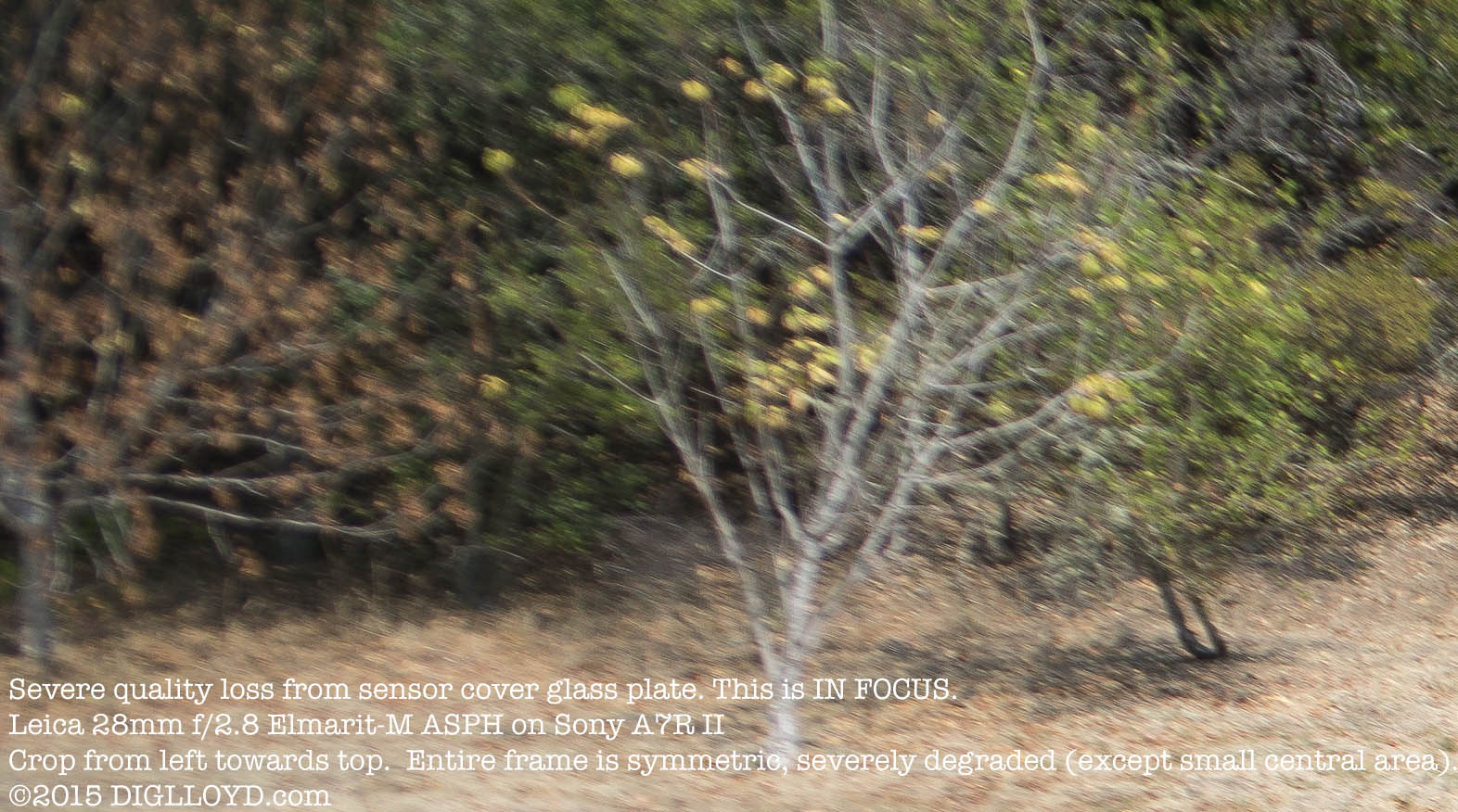Sony A7R II with Leica M Lenses

Get Sony A7R II at B&H Photo.
The basic problem with image quality with rangefinder lenses on all Sony mirrorless cameras is the use of relatively thick sensor cover glass. Rays from the lens must pass through this glass, and in so doing a severe astigmatism is created (very strong smearing) along with chromatic aberrations, caused by a displacement in focus of the sagittal and tangential rays. There can be other issues, including various flares.
- Astigmatism and Digital Sensors, which explains the technical reasons why no sensor can fix the severe astigmatism and lateral chromatic aberration issues caused by use of a lens on a sensor having a glass plate over it (sensor cover glass) which is relatively thick versus the lens design parameters.
- Ray Angle, Vignetting, Color Shading on a Digital Sensor articles
- Filter Stack Thickness vs Digital Sensors.
- Astigmatism and Lateral Color: Why Performance is Lens + Sensor (aka why do my expensive lenses suck on mirrorless)
The internet is abuzz with claims from those who think that the laws of optics have been repealed for the Sony A7R II, just because it has a new sensor.
These claims seem to be based on seeing less color shading, but this has always varied by sensor (magenta with some Sony sensors, green with others). Better neutrality is good, but it’s silly to think this means a whole lot. Sony cannot change the thickness of the sensor cover glass without altering the optical path, and this would degrade image quality with lenses designed for it (and in ways that test benches won’t necessarily show, such as color aberrations, bokeh and flares). So the A7R II has the same sensor cover glass thickness as all its siblings. Hence its imaging performance with steep ray angle lenses (e.g., Leica M, Zeiss ZM, etc) is not going to change vs previous Sony mirrorless models.
Well, I always believe in checking even if it is logically impossible, so I did, using the Leica 28mm f/2.8 Elmarit-M ASPH. The sharpness losses outside a small central area are severe, just as expected, very badly blurred/smeared over most of the frame.
In about two weeks, I should have a KolariVision-modified Sony A7R II which I will pit against my unmodified A7R II. That will show the massive quality loss that occurs in the unmodified camera.
Example
It’s amazing to me that anyone can look at results like this and claim that Leica M lenses work great on any Sony body (unmodified). Even the 50/2 APO needs f/5.6 to overcome the losses from the sensor cover glass! See the links below—yes you can get decent (but not optimal) results by stopping down to f/11 with Leica wide angles. And you can get vastly superior results wide open with native lenses costing far less.
Image below is at 50% of actual pixels, so it is even worse than it looks. It is IN FOCUS and at peak performance! Severe astigmatism as well as lateral chromatic aberration are caused by wave-plate displacement of sagittal and tangential rays. The new Sony A7R II sensor is hugely better for color shading, but no sensor can undo the damage done by the sensor cover glass. View a larger-width crop.

Sony A7R II + Leica 28mm f/2.8 Elmarit-M ASPH
[low-res image for bot]
M lenses evaluated
The prior Leica M lens evaluations with the Kolarivision-modified Sony A7R can be found in Guide to Leica, comparing a modified to unmodified Sony A7R:
- Ray Angle From Lens Exit Pupil (Table of Ray Angles for Zeiss ZM Lenses)
- Leica 18/3.8 Super-Elmar-M ASPH: Sensor Cover Glass: Stock vs Kolarivision Modified Sony A7R (Mosaic)
- Leica 21/3.4 Super-Elmar-M ASPH: Sensor Cover Glass: Stock vs Kolarivision Modified Sony A7R (Mosaic)
- Leica 24/3.8 Elmar-M ASPH: Sensor Cover Glass: Stock vs Kolarivision Modified Sony A7R (Mosaic)
- Leica 28/2.8 Elmarit-M ASPH: Sensor Cover Glass: Stock vs Kolarivision Modified Sony A7R (Mosaic)
- Leica 50mm f/2 APO-Summicron-M ASPH: Sensor Cover Glass: Stock vs Kolarivision Modified Sony A7R (Mosaic)



























